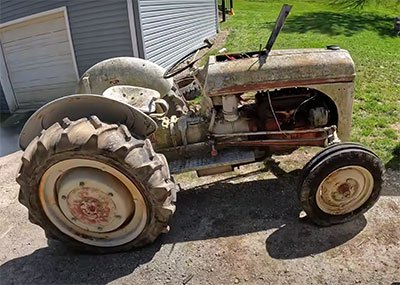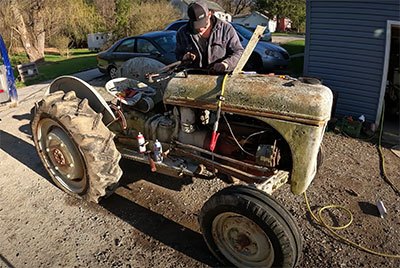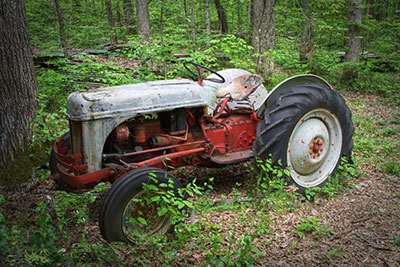Ford tractors have a long history, more than 100 years long. However, the Ford N-Series stands out with its 2N, 8N, and 9N models due to the collaboration with Ferguson.
The question is: Why should you choose the Ford 9N tractor among all others?
Our Ford 9N tractor reviews discuss specs, features, and the product line history of the 9N model.
Take away Key Points:
- The 9N is a 2WD utility tractor with a four-cylinder gasoline engine and a sliding gear transmission with three forward and one reverse gear.
- The 9N has manual settings.
- The N-Series included two other units: 2N and 8N.
Table of Contents
- Ford 9N Tractor Analysis: All You Need to Know
- 1. The Ford tractor history
- 2. Ford 9N dimensions
- 3. Ford 9N mechanics
- 4. Ford 9N tractor engine specs
- 5. Ford 9N tractor power
- 6. Ford 9N tractor transmission
- 7. Ford 9N tractor three-point hitch
- 8. Ford 9N tractor fuel capacity
- 9. Ford 9N tractor wheels and tires
- 10. Ford 9N PTO
- 11. Ford 9N tractor electricity
- FAQs
- The Final Words
Ford 9N Tractor Analysis: All You Need to Know
If you’re wondering whether you need the Ford tractor, read the specs to decide better.

1. The Ford tractor history
The Ford N-Series tractors were a product line of row-crop tractors produced by the Ford Motor Company between 1939 and 1952. The most popular models included the 2N, 8N, and 9N tractors. The Ford factory was located in Dearborn, Michigan, USA.
The Ford 9N tractor was the first American-made with a three-point hitch system, following Ferguson. The design is still used on most modern tractors.
The first model was presented in October 1939. However, the serial numbers changed with the years, including:
- 1939: 1
- 1940: 10234
- 1941: 45976
- 1942: 89888
The original 1939 price was $585, and the manufacturer produced 99,002 models.
2. Ford 9N dimensions
The Ford-Ferguson tractor is a small utility product suitable for lighter farm operations, ideal for everyday use. However, the compact design still offers a high performance to finish your tasks quickly. Remember that this is an older product, so it provides maximum strength proportional to its years. First, let’s see the overall specs.
Dimension specs
| Shipping weight | 2140 pounds |
| Operating weight | 2900 pounds |
| Ballasted weight | 3375 pounds |
| Length | 115 inches |
| Width | 64 inches |
| Height | 52 inches |
| Ground clearance | 13 inches |
| Front tread | 48-76 inches |
| Rear tread | 48-76 inches |
3. Ford 9N mechanics
The mechanics include the overall design and functioning of the tractor. Thus, the tractor is smaller, more compact, and ideal for smaller farms.
However, the issue might be the left brake. Namely, the 9N uses separate brakes; the left pedal is on the left side, while the 8N has both brakes on the right side. Thus, you can press the pedals with only one leg.
In addition, the 9N doesn’t have position controls as addition and improvement to the hydraulic system. The overall design isn’t modern on all three tractors in the Ford N-Series, but they were in good shape back in the day. Let’s take a look at the specifications for a better understanding.
Overall specs
| Chassis | 4×2 2WD |
| Steering | Manual steering |
| Brakes | Different mechanical shoe |
| Cab | Open operator station |
4. Ford 9N tractor engine specs
The 9N machine is a good tractor due to the four-cylinder gasoline engine. Moreover, the engine is a liquid-cooled one with a more coolant capacity. Though nowadays a diesel engine is more efficient and saves energy, during the 20th century, this engine type was a revolution.
The liquid-cooled engines maintain higher speeds for an extended period and keep the machine cooler without affecting its performance. As a result, the engine has a longer lifespan than an air-cooled engine.
Insufficient coolant capacity leads to damage to the engine parts, so the Ford 9N tractor offers an ideal engine for all farming tasks.
Engine specs
| Engine type | Ford gasoline four-cylinder liquid-cooled inline |
| Bore/stroke | 3,188 x 3.75 inches |
| Air cleaner | Oil bath |
| Compression | 6.0:1 |
| RPM | 2000 |
| Torque | 84 lb-ft |
| Torque RPM | 1500 |
| Oil change | 200 hours |
| Coolant capacity | 12 qts |
5. Ford 9N tractor power

The Ford 9N tractor is famous for its power capacity. In addition, the tractor uses a drawbar that ensures the tractor will haul massive loads. Thanks to its shape, the loader can attach multiple farm attachments, including a bucket, brush hog, plow, trailer, and similar farm equipment for a pasture, field, plowing snow, etc.
Thanks to the power, the drawbar will serve you for many years and provide you with real work after attaching the tractor extensions. Of course, you can also use the machinery as a front loader and add a bucket, similar to the 8N unit.
Power specs
| Drawbar (claimed) | 12.68 hp |
| Belt (claimed) | 20.29 hp |
| Plow numbers | 2 (14 inches) |
| Drawbar (tested) | 16.31 hp |
| Belt (tested) | 23.56 hp |
6. Ford 9N tractor transmission
The Ford 9N tractor uses sliding gear as the transition. It offers three forward and one reverse shift, but the clutch and the brake pedals are separate. And you must press the clutch manually to change the gears.
Transmission specs
| Transmission | Sliding gear |
| Gear types | Three forward, and one reverse |
| Oil Capacity | 20 qts |
| Oil type | 32°F [0°C]↑ SAE90 GL1 32°F [0°C]↓ SAE80 GL1 |
7. Ford 9N tractor three-point hitch
The three-point hitch on the Ford 9N tractor is Category 1. It’s typical for tractors between 20 and 50 hp. The hitch offers ¾ inches in diameter, and the two lift arm pins are slightly thicker at ⅞ inches. In addition, the spacing between the arms is approximately 26 inches.
Hitch specs
| Rear type | Category 1 |
| Rear lift | 800 pounds |
8. Ford 9N tractor fuel capacity
The Ford 9N tractor utilizes a 10-gallon fuel tank for the best performance. Thus, you can finish all the work on your land, and the tractor doesn’t use too much fuel. As a result, the tractor is quite efficient for the old Fords. However, the 8N and 2N tractors also use the 10-gallon fuel tank capacity, so there are no big differences in the performance.
Fuel tank capacity
| Capacity | 10 gallons |
9. Ford 9N tractor wheels and tires
Since the Ford-Ferguson tractor is a row-crop unit suitable for multiple farm operations, the tires are also good for performance. As a result, the tractor runs smoothly and fast on your field, and there won’t be instability or easy wheel damage.
The steel wheels resist all external impacts and pressure, keeping your tractor optimal for all heavy and light-duty farm working conditions. They also offer six lug bolts on the rear wheels in a broad pattern and are easily recognizable.
Tire specs
| Front tires | 4.00-19 |
| Rear tires | 8.00-32 |
| Wheelbase | 70 inches |
10. Ford 9N PTO
Although not the first tractor with the PTO mechanism, the Ford-Ferguson tractor offers an effective transmission to the end loaders and similar tractor implements.
However, the non-live PTO with a three-point conversion might not be the best solution for the snowblower. Instead, you might choose the Ford 8N for the live hydraulics, power steering, and live PTO for the tasks on your land.
Still, the rear PTO of the 9N tractor allows you to attach and utilize a bush hog, mower, tillers, etc., and operate on your small farm successfully. The rear 545 RPM provides sufficient energy for quick operations.
PTO specs
| Rear PTO | Transmission |
| Rear RPM | 545 |
11. Ford 9N tractor electricity
Although the specs state six charging volts and 16 amps, you can use the 12V battery. The 12V battery works well with a high “cold starting amps” rating and a 6V starter as opposed to a 12V battery with a low “hard starting amp” rating.
The process doesn’t make any difference. The battery doesn’t affect the starter and won’t create more torque in the starter, so it cannot damage the flywheel.
Instead, the cold starting rating affects the battery’s chemistry, not the starter. The battery will supply what the starter demands. For example, a starter requires 50 amps, and the battery can supply 1000 amps at 12 volts. The battery provides 50 amps at 12 volts.
However, the starter demands 50 amps, and the battery can only supply 40 amps at 12 volts; the chemistry makes the battery supply 50 amps at 11 volts.
Electricity specs
| Ground | Positive |
| Charging system | Generator |
| Charging amps | 16 |
| Charging volts | 6 |
| Battery volts | 6 |
| Battery AH | 85 |
FAQs
Where can you find a Ford 9N tractor nowadays?
After World War II, the production of tractors stopped. However, nowadays, you can find some old units restored and sold at the local auction for a good price. The sale goes from $1000 and slightly more, but nothing extreme.
You can compare and find the serial numbers on the left hand of the engine block to determine if the digits are correct. A limited number of products are painted gray – the favorite color of the first tractors.
What are the alternatives?

As previously mentioned, the Ford N-Series also came with two other tractors, 8N and 2N. The 9N and 2N are similar in specifications, but there are different factors in the two units, and they’re different from the new model 8N.
However, you can also look for the old Massey Ferguson or John Deere tractors, such as MF35 or JD’s H-Series, to compare their specs and serial numbers and see the best option. However, all of these models are older, so they might not offer as powerful performance as their modern units have nowadays.
Differences between the 9N, 2N, and 8N
The main differences between the products include the following:
- The 2N and 9N have a flat rear wheel with six lug nuts further out, while the 8N has a large lug nut in the center and more lug nuts surrounding it.
- 8N uses a four-speed transmission, whereas 2N and 9N have only three.
- 2N and 9N only provide a draft control, while the three-point arms in 8N offer a halfway position between the fully up or down configurations. In addition, the 8N has a position control to improve the hydraulic system, which the 2N and 9N miss.
- 8N has both pedals on the same side, split into 2N and 9N tractors.
- 8N had running boards for placing your feet, while the 9N had only foot pegs. Running boards were more comfortable.
Differences between 2N and 9N tractors
The differences include:
- 9N had a three-spoke steering wheel with covered spokes, while the 2N had exposed metal spokes
- 9N had a steering wheel with vertical spokes, whereas the 2N had a grill with a slotted center bar
- 9N used the riveted rear axle hubs to replace the ‘smooth’ rear axle, while the 2N had the hood side panels exposing bolts to retain the front axle support
- 9N moved the ignition key switch to the steering column
- 2N had fender mount holes in the rear axle housing, but it was no longer solid. They were opened between upper and lower vertical holes.
- The 9N parts were used to build the 2N tractors.
The Final Words
The Ford 9N tractor was a revolutionary product during the first half of the 29th century due to its strength, power take-off, oil capacity, and performance. The construction was durable and reliable (even today), so the loader is helpful in the field.
Many farmers still have it only for fun and exhibitions, while others keep it as a family legacy and perform multiple operations with the tractor.
